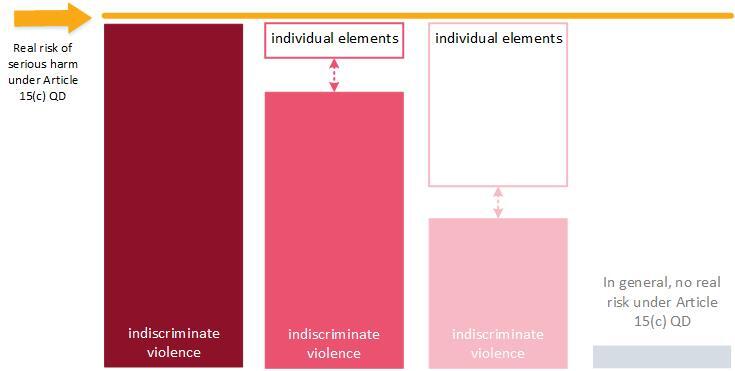COMMON ANALYSIS
Last updated: June 2022
‘Indiscriminate violence’ refers to the source of the specific type of serious harm defined in Article 15(c) QD. The CJEU in Elgafaji notes that the term ‘indiscriminate’ implies that the violence,

[…] may extend to people irrespective of their personal circumstances.
CJEU, Elgafaji, para.34
Some acts of violence may be indiscriminate by their nature, for example: (suicide) bombings, attacks and armed confrontations in areas that are inhabited or frequented by civilians (e.g. marketplaces, public roads, healthcare facilities).

In armed conflicts the targeting of civilians may have nexus to one of the reasons for persecution according to the refugee definition.
Therefore, refugee status may be granted as noted in the section above (see, for example, the profiles 2.1 Persons (perceived to be) affiliated with ISIL, 2.9 Individuals perceived to oppose ISIL, 2.15 Religious and ethnic minorities, and stateless persons). Such targeted violence, furthermore, would not be considered ‘indiscriminate’.
Based on Elgafaji, in situations where indiscriminate violence is taking place, the following differentiation can be made with regard to its level:
Figure 8. Levels of indiscriminate violence on the basis of CJEU, Elgafaji, para.43.

With regard to the second category (text box on the right), Elgafaji provides guidance on how the serious and individual threat has to be assessed, an approach commonly referred to as the ‘sliding scale’:

[…] the more the applicant is able to show that he is specifically affected by reason of factors particular to his personal circumstances, the lower the level of indiscriminate violence required for him to be eligible for subsidiary protection.
CJEU, Elgafaji, para.39
See further guidance on this in the sub-section Serious and individual threat.
The graph below illustrates the further differentiated standard scale applied in country guidance with regard to the different levels of indiscriminate violence and the respective degree of individual elements required in order to find that a real risk of serious harm under Article 15(c) QD is substantiated for the applicant:
Figure 9. Indiscriminate violence and individual elements in establishing real risk of serious harm under Article 15(c) QD.

Depending on the level of indiscriminate violence taking place, the territories in a country can be categorised as follows.
|
|
|
|
Territories where the degree of indiscriminate violence reaches such an exceptionally high level that substantial grounds are shown for believing that a civilian, returned to the relevant country or, as the case may be, to the relevant region, would, solely on account of his or her presence on the territory of that country or region, face a real risk of being subject to the serious threat referred to in Article 15(c) QD. |
|
|
|
|
Territories where ’mere presence’ in the area would not be sufficient to establish a real risk of serious harm under Article 15(c) QD, however, indiscriminate violence reaches a high level, and, accordingly, a lower level of individual elements is required to show substantial grounds for believing that a civilian, returned to the territory, would face a real risk of serious harm in the meaning of Article 15(c) QD. |
|
|
Territories where indiscriminate violence is taking place, however not at a high level and, accordingly, a higher level of individual elements is required in order to show substantial grounds for believing that a civilian, returned to the territory, would face a real risk of serious harm in the meaning of Article 15(c) QD. |
Lastly, there are territories with regard to which Article 15(c) QD would in general not be applicable, either because the criteria for an armed conflict within the meaning of this provision are not met or because no indiscriminate violence is taking place or because the level of indiscriminate violence taking place is so low, that in general there would be no real risk for a civilian to be affected by it.
|
|
Territories where, in general, there is no real risk for a civilian to be personally affected within the meaning of Article 15(c) QD. |

Continue reading:
